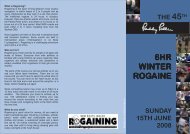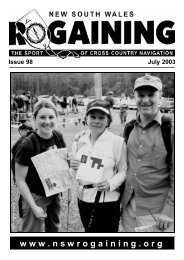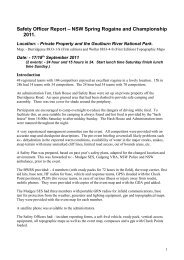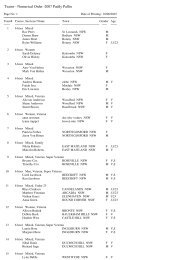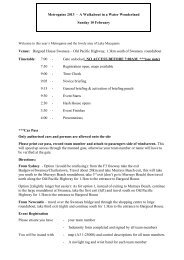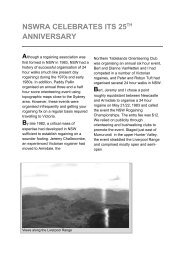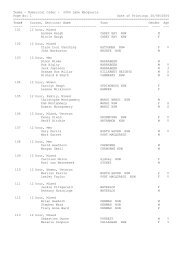VRA novice pack 2002 - NSW Rogaining Association
VRA novice pack 2002 - NSW Rogaining Association
VRA novice pack 2002 - NSW Rogaining Association
You also want an ePaper? Increase the reach of your titles
YUMPU automatically turns print PDFs into web optimized ePapers that Google loves.
ON THE COURSE<br />
The score card<br />
Before heading out on the course, there are a few things you need<br />
to know about what you’re looking for and what to do when you<br />
find it – i.e. you need to know about Score Cards and Checkpoints.<br />
The score card is a sheet of plasticised paper with a grid of<br />
numbered squares on it (see Figure). It is used to prove you<br />
have visited a checkpoint. If, for example, you visit checkpoint<br />
45, you use the punch to clip your score card in the square<br />
numbered 45. There is only one score card per team, so don’t<br />
lose it! You collect your team’s score card at the start.<br />
At the checkpoint<br />
If you are lost<br />
T <strong>Rogaining</strong> Tip<br />
If lost<br />
Do not split up<br />
Locate roads nearby and<br />
head for these<br />
Stick to tracks<br />
Use your whistle to<br />
attract attention<br />
When your team reaches a checkpoint you must punch the box on<br />
the score card that corresponds to that checkpoint number. You<br />
also need to fill in the intention sheet hanging from the checkpoint<br />
with your team number, time and proposed next checkpoint. This<br />
helps the organisers if you become lost and are late returning.<br />
If you think you are lost, DON’T PANIC. Try to determine where<br />
you were last sure about your position and back track to that<br />
point. If you can’t back track to a known position, stop and have<br />
a rest and a bite to eat. Think about where you are. Are there<br />
any major roads or other recognisable features near your<br />
general area that you could reach without too much trouble and<br />
use to guide you back to the Hash House<br />
If you are really lost with no idea how to reach a major<br />
road/highway, railway line or similar linear feature, stay put and<br />
consider when a search will be mounted. DO NOT SPLIT UP. If<br />
you are not back at the Hash House within 1 hour of the finish,<br />
a vehicle search by road will begin. If you are on a road, do not<br />
leave the road in the hope of reaching the Hash House crosscountry.<br />
You will be more easily found if you stick to tracks.<br />
The checkpoint<br />
T <strong>Rogaining</strong> Tip<br />
It’s a good idea if one<br />
person punches the<br />
score card and one fills<br />
in the intention sheet<br />
If you visit a checkpoint<br />
but do not punch your<br />
score card, you will not<br />
receive any points for<br />
your visit. “No Punch, No<br />
Points” is <strong>VRA</strong> policy<br />
All team members must<br />
simultaneously get to within<br />
20m of the checkpoint<br />
You should not rest within<br />
100m of a checkpoint<br />
unless it is at a water drop.<br />
This can ‘give away’ the<br />
checkpoint location to other<br />
teams and detract from<br />
their enjoyment of the event<br />
The checkpoint is a white and orange corflute marker hanging in a<br />
tree or on a fence post (see picture). It is not meant to be difficult to<br />
find, just as long as you’ve navigated to the correct location. The<br />
checkpoint has two things attached to it – a punch to mark your score<br />
card, and an intentions sheet to show where you plan to go next.<br />
Some checkpoints – known as metal checkpoints - are simply<br />
white and orange metal plates chained to a feature, with a punch<br />
bolted to them. These checkpoints are used in areas very<br />
accessible to the public, and cannot be tampered with, stolen, or<br />
destroyed as easily as the corflute checkpoints. They usually do<br />
not have intentions sheets attached to them.<br />
If a vehicle search along major roads fails to locate you a more<br />
intensive foot search will be initiated. During a foot search,<br />
intention sheets will be used to determine your movements<br />
throughout the event and isolate a search area. At the same<br />
time, a check of car registrations and tents will be made to<br />
check if you have returned to the Hash House and not returned<br />
your score card to Admin. Phone calls will also be made to<br />
check you haven’t gone home.<br />
Use your whistle to attract attention – THREE blasts at regular<br />
intervals is the recognised distress signal. If you are still<br />
missing after the foot search the Police will be called in to<br />
conduct a more thorough search. (Note that, at the time of<br />
writing, the <strong>VRA</strong> has never had to do this.)<br />
If you are missing following the completion of a 12 hour event,<br />
a thorough search may not be initiated until first light the next<br />
morning depending on the conditions.<br />
Page 20 Which way’s north An introduction to <strong>Rogaining</strong> Victorian <strong>Rogaining</strong> <strong>Association</strong><br />
Victorian <strong>Rogaining</strong> <strong>Association</strong> Which way’s north An introduction to <strong>Rogaining</strong> Page 21



